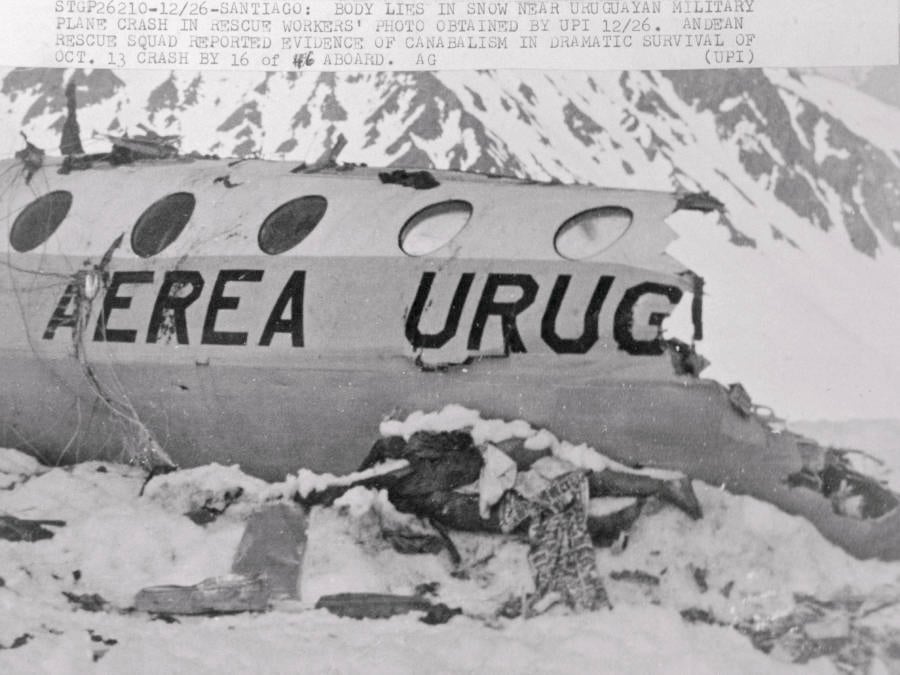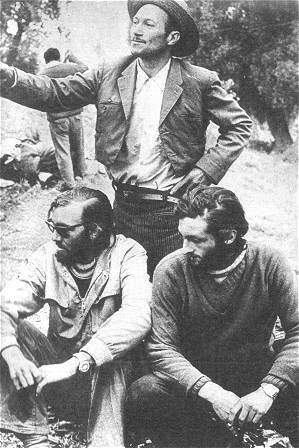When a plane carrying a rugby team crashed in the Andes Mountains in October 1972, Nando Parrado risked his life to save the surviving passengers from starvation — and cannibalism.

Jeff Morgan 05 / Alamy Stock PhotoNando Parrado went on to become a writer and motivational speaker in the decades after the plane crash that took the lives of his mother, sister, best friend, and 26 others.
Nando Parrado was one of the 45 passengers who boarded Uruguayan Air Force Flight 571 on Friday, October 13, 1972.
Parrado, along with 18 of the other passengers, was part of a Uruguayan amateur rugby team. Together with their friends and family, the team members were traveling in a chartered plane to play a match in Chile.
As he settled into his seat, Parrado had no inkling that not only would he soon spend a harrowing 72 days in frigid temperatures at the top of a mountain, but he would soon be dining on the flesh of those around him.
Decades later, Parrado chronicled this incredible story of survival against the odds in his book Miracle in the Andes. Read on to learn more about Nando Parrado, the man who trekked through the Andes to save the lives of his fellow plane crash survivors.
Nando Parrado’s Life Before The Plane Crash
Fernando “Nando” Seler Parrado Dolgay was born on Dec. 9, 1949, in Montevideo, the capital of Uruguay. He was the second of three children born to Seler Parrado and Xenia Dolgay, an immigrant from Ukraine. His parents ran a successful hardware store that allowed the family to live comfortably in Carrasco, one of the most prestigious neighborhoods in Montevideo. There, he attended Stella Maris College, a private Catholic school.
Growing up, Parrado dreamed of becoming a race car driver like his idol, British Formula One racer Jackie Stewart. However, he ultimately decided to follow a more practical path and study business after high school.
Outside of his studies, Parrado continued to pursue his hobbies. As he wrote in Miracle in the Andes, “I played rugby, I chased girls with [my best friend] Panchito, I raced my little Renault along the beach roads at Punte del Este, I went to parties and lay in the sun, I lived for the moment, drifting with the tide, waiting for my future to reveal itself.”
Because of his love for rugby, Parrado joined his high school’s amateur alumni rugby team, the Old Christians — a decision that would change his life forever.
The Crash Of Uruguayan Air Force Flight 571
In October 1972, the Old Christians rugby team headed to Chile to participate in a match, and many of the players brought their families along with them. Of the 45 passengers who boarded the plane on Oct. 13, 19 were part of the rugby team, 21 were friends or family, and five were crew members.

Bettmann / Getty ImagesA decomposing body lies in snow outside the wreckage of the Uruguayan plane that crashed in the Andes on Oct. 13, 1972.
About an hour into the flight, everything suddenly went wrong. The pilots had decided to take an indirect route to Chile to avoid flying directly over the Andes Mountains, as the plane couldn’t ascend high enough to clear the towering peaks. However, due to low visibility, they lost their way.
The plane was actually flying through the Andes, and it soon smashed into a ridge. The collision ripped off the aircraft’s wings and sent the fuselage sledding down an icy slope. Eleven of the passengers, including Parrado’s mother and his best friend, Panchito, died instantly, and the survivors were left stranded in frigid temperatures nearly 12,000 feet above sea level.
Parrado lay unconscious for three days following the crash. Nobody tried to revive him, as they assumed he was dead. A doctor later told Parrado that this likely saved his life, as the cold and dehydration kept his injured brain from swelling.
When he awoke, he learned that his younger sister was also close to death. Tragically, she passed away despite Parrado’s efforts to tend to her injuries. With his loved ones dead, he was left to join his teammates in their fight for survival.
The cold was the survivors’ most pressing problem. The team was not dressed for such low temperatures, and the warmest clothing many of the players had was their sports jackets. However, the plane’s crumpled fuselage provided just enough cover to protect them from the worst of the winds.
After the cold, thirst was their greatest concern. At high altitudes, humans become dehydrated much more quickly than they do at sea level, often without even realizing it. One ingenious passenger managed to create a water basin using aluminum from the wreck to melt the ice in the sunlight. But it was hunger that would soon become the survivors’ worst problem.
As the days went by with no sign of rescue, the passengers felt the appetites that had been suppressed by shock and fear slowly return. As their small rations ran out, Nando Parrado found himself gazing at the wounded leg of a boy on the plane. As he stared at the dried blood around the injury, he suddenly felt his appetite rise, according to an excerpt from his book published in The Guardian.
No matter how morally repulsive Parrado found the idea, as he explained it, “Something had happened that I couldn’t deny: I had looked at human flesh and instinctively recognized it as food.”
Nando Parrado Turns To Cannibalism
At first, the survivors were too ashamed to admit their cannibalistic thoughts to each other. But as their mountain isolation dragged on, they all realized they would soon have to make a difficult choice to survive.
Parrado finally broached the taboo subject with another passenger during a discussion about how they were too weak to attempt climbing down the mountains themselves without nourishment. After Parrado tentatively declared, “There is plenty of food here, but you must think of it only as meat,” his friend quietly admitted, “God help us, I have been thinking the very same thing.”

Everett Collection Historical / Alamy Stock PhotoSurvivors of the Uruguayan plane crash in the Andes shortly after rescuers arrived.
No longer able to postpone the inevitable, the remaining survivors joined hands and gave each other permission to consume their bodies if they, too, perished on the mountain. Moments later, they took their first bite of human flesh. As Parrado recalled, “I felt no guilt or shame. I was doing what I had to do to survive.”
The survivors had long since accepted that no rescue was coming for them. In fact, both Uruguayan and Chilean authorities had called off the search for the missing plane just 11 days after the crash. They thought it would have been impossible for anyone who might have survived to last that long in the Andes without food or shelter.
Although some of the players’ family members had attempted to keep the search going, Parrado admitted, “Deep down, I always knew we would have to save ourselves.”
Nando Parrado And Roberto Canessa Set Out To Find Help
Around 60 days after the crash, Roberto Canessa approached Nando Parrado and simply said, “It’s time to go.” Together with another survivor named Antonio Vizintín, who later returned to the crash site after the “expeditionaries” began to run out of food, Parrado began the arduous trek down the mountain in a desperate attempt to bring back help.
During the miserable 10-day journey, Parrado declared to Canessa, “We may be walking to our deaths, but I would rather walk to meet my death than wait for it to come to me.”
Canessa replied, “We have been through so much. Now let’s go die together.” Thankfully, at the end of their journey, they found not death but hope.

Wikimedia CommonsNando Parrado and Roberto Canessa with Sergio Catalán, the man who first spotted them and rode for help.
On Dec. 20, as the pair traveled alongside a river, Canessa suddenly shouted out, “I see a man!”
Although he initially thought his friend was seeing things, Nando Parrado soon heard “the unmistakable sound of a human voice.” They signaled for help, and the man quickly set out to alert authorities.
On Dec. 22, the first helicopters reached the crash site. Of the 45 people who initially boarded the plane, only 16 had survived.
The incredible rescue made headlines all over the world, although the story of the miraculous survival was soon overshadowed by the reports of cannibalism.
Although the public initially reacted with horror (even though a Catholic priest had declared the survivors had not sinned since they had only resorted to cannibalism in extremis), the team gave a remarkably honest press conference explaining their desperation and pact to each other, after which the outrage died down. The survivors shared a truly unique bond after their experience, one that was not marked by shame.
“I have suffered great losses and have been blessed with great consolations,” Nando Parrado later wrote, “but whatever life may give me or take away, this is the simple wisdom that will always light my life: I have loved, passionately, fearlessly, with all my heart and all my soul, and I have been loved in return. For me, this is enough.”
After reading about the courageous story of Nando Parrado, read about Joseph Stalin’s “Cannibal Island.” Then, check out these harrowing photos from the unsolved Dyatlov Pass incident.





